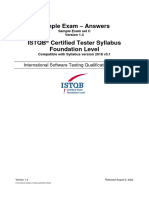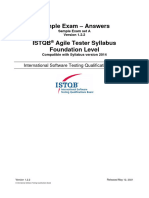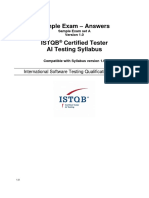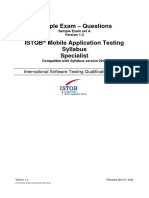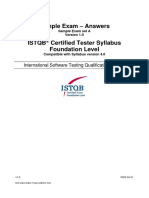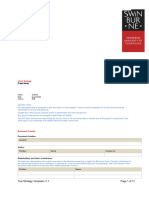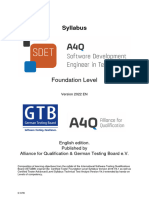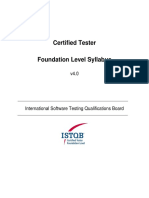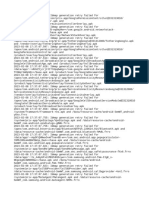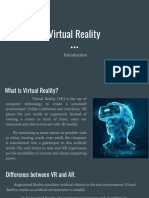ISTQB CT AuT Sample Exam A Answers v2.2
ISTQB CT AuT Sample Exam A Answers v2.2
Uploaded by
monika bhusaCopyright:
Available Formats
ISTQB CT AuT Sample Exam A Answers v2.2
ISTQB CT AuT Sample Exam A Answers v2.2
Uploaded by
monika bhusaOriginal Title
Copyright
Available Formats
Share this document
Did you find this document useful?
Is this content inappropriate?
Copyright:
Available Formats
ISTQB CT AuT Sample Exam A Answers v2.2
ISTQB CT AuT Sample Exam A Answers v2.2
Uploaded by
monika bhusaCopyright:
Available Formats
Sample Exam – Answers
Sample Exam set A
Version 2.2
ISTQB® Automotive Software Tester
Syllabus
Specialist
Compatible with Syllabus version 2018
International Software Testing Qualifications Board
German Testing Board
Version 2.2 Released May 12, 2023
© International Software Testing Qualifications Board
Automotive Software Tester, Specialist
Sample Exam set A
Sample Exam – Answers
Copyright Notice
Copyright Notice © International Software Testing Qualifications Board (hereinafter called
ISTQB®).
ISTQB® is a registered trademark of the International Software Testing Qualifications Board.
All rights reserved.
The authors hereby transfer the copyright to the ISTQB®. The authors (as current copyright
holders) and ISTQB® (as the future copyright holder) have agreed to the following conditions of
use:
Extracts, for non-commercial use, from this document may be copied if the source is
acknowledged.
Any Accredited Training Provider may use this sample exam in their training course if the authors
and the ISTQB® are acknowledged as the source and copyright owners of the sample exam and
provided that any advertisement of such a training course is done only after official Accreditation of
the training materials has been received from an ISTQB®-recognized Member Board.
Any individual or group of individuals may use this sample exam in articles and books, if the
authors and the ISTQB® are acknowledged as the source and copyright owners of the sample
exam.
Any other use of this sample exam is prohibited without first obtaining the approval in writing of the
ISTQB®.
Any ISTQB®-recognized Member Board may translate this sample exam provided they reproduce
the abovementioned Copyright Notice in the translated version of the sample exam.
Document Responsibility
The ISTQB® Examination Working Group is responsible for this document.
Acknowledgements
This document was produced by a core team from the ISTQB®: Exam Working Group and German
Testing Board
The core team thanks the Exam Working Group review team, the Syllabus Working Group and the
National Boards for their suggestions and input.
This document is maintained by a core team from ISTQB® consisting of the Syllabus Working
Group and Exam Working Group.
Version 2.2 Page 2 of 22 May 12, 2023
© International Software Testing Qualifications Board
Automotive Software Tester, Specialist
Sample Exam set A
Sample Exam – Answers
Revision History
Sample Exam – Answers Layout Template used: Version 2.5 Date: Maj 21, 2021
Version Date Remarks
2.2 May 12, 2023 Correction of Answer: #20
2.1.1 May 25, 2021 Update of Copyright Notice
2.1 November 12, 2019 Layout update
2.0 July 4, 2018 Updated in connection with ISTQB release
1.0 2015 First edition
Version 2.2 Page 3 of 22 May 12, 2023
© International Software Testing Qualifications Board
Automotive Software Tester, Specialist
Sample Exam set A
Sample Exam – Answers
Table of Contents
Copyright Notice ............................................................................................................................. 2
Document Responsibility................................................................................................................. 2
Acknowledgements ......................................................................................................................... 2
Revision History .............................................................................................................................. 3
Table of Contents............................................................................................................................ 4
Introduction ..................................................................................................................................... 5
Purpose of this document ............................................................................................................ 5
Instructions .................................................................................................................................. 5
Answer Key..................................................................................................................................... 6
Answers .......................................................................................................................................... 7
1 ................................................................................................................................................................. 7
2 ................................................................................................................................................................. 7
3 ................................................................................................................................................................. 7
4 ................................................................................................................................................................. 8
5 ................................................................................................................................................................. 8
6 ................................................................................................................................................................. 8
7 ................................................................................................................................................................. 9
8 ................................................................................................................................................................. 9
9 ................................................................................................................................................................. 9
10 ............................................................................................................................................................. 10
11 ............................................................................................................................................................. 10
12 ............................................................................................................................................................. 10
13 ............................................................................................................................................................. 11
14 ............................................................................................................................................................. 11
15 ............................................................................................................................................................. 12
16 ............................................................................................................................................................. 12
17 ............................................................................................................................................................. 13
18 ............................................................................................................................................................. 13
19 ............................................................................................................................................................. 14
20 ............................................................................................................................................................. 14
21 ............................................................................................................................................................. 14
22 ............................................................................................................................................................. 14
23 ............................................................................................................................................................. 15
24 ............................................................................................................................................................. 15
25 ............................................................................................................................................................. 15
26 ............................................................................................................................................................. 15
27 ............................................................................................................................................................. 16
28 ............................................................................................................................................................. 16
29 ............................................................................................................................................................. 17
30 ............................................................................................................................................................. 17
31 ............................................................................................................................................................. 18
32 ............................................................................................................................................................. 19
33 ............................................................................................................................................................. 19
34 ............................................................................................................................................................. 19
35 ............................................................................................................................................................. 20
36 ............................................................................................................................................................. 20
37 ............................................................................................................................................................. 20
38 ............................................................................................................................................................. 20
39 ............................................................................................................................................................. 21
40 ............................................................................................................................................................. 22
Version 2.2 Page 4 of 22 May 12, 2023
© International Software Testing Qualifications Board
Automotive Software Tester, Specialist
Sample Exam set A
Sample Exam – Answers
Introduction
Purpose of this document
The sample questions and answers and associated justifications in this sample exam set have
been created by a team of Subject Matter Experts and experienced question writers with the aim of
assisting ISTQB® Member Boards and Exam Boards in their question writing activities.
These questions cannot be used as-is in any official examination, but they should serve as
guidance for question writers. Given the wide variety of formats and subjects, these sample
questions should offer many ideas for the individual Member Boards on how to create good
questions and appropriate answer sets for their examinations.
Instructions
In this document you may find:
Answer Key table, including for each correct answer:
- K-level, Learning Objective, and Point value
Answer sets, including for all questions:
- Correct answer
- Justification for each response (answer) option
- K-level, Learning Objective, and Point value
Additional answer sets, including for all questions [does not apply to all sample exams]:
- Correct answer
- Justification for each response (answer) option
- K-level, Learning Objective, and Point value
Questions are contained in a separate document
Version 2.2 Page 5 of 22 May 12, 2023
© International Software Testing Qualifications Board
Automotive Software Tester, Specialist
Sample Exam set A
Sample Exam – Answers
Answer Key
Question Correct Answer LO K-Level Points Question Correct Answer LO K-Level Points
Number (#) Number (#)
1 d AuT-1.3 K1 1 21 d AuT-2.4.2 K2 1
2 c - K1 1 22 a AuT-3.1.2 K1 1
3 b - K2 1 23 d AuT-3.1.4 K1 1
4 c - K1 1 24 b AuT-3.1.3 K2 1
5 a AuT-2.1.1 K2 1 25 c AuT-3.2.1 K2 1
6 c K2 1 26 a AuT-3.2.2 K1 1
7 c AuT-2.1.2 K3 1 27 d AuT-3.2.2 K1 1
8 b AuT-2.1.2 K3 1 28 c AuT-3.2.3 K2 1
9 b AuT-2.1.2 K3 1 29 b AuT-3.2.4 K3 1
10 b AuT-2.1.2 K3 1 30 a AuT-3.2.1 K2 1
11 c AuT-2.2.1 K2 1 31 c AuT-3.2.3 K2 1
12 a AuT-2.2.4 K2 1 32 b AuT-3.2.4 K3 1
13 a AuT-2.2.3 K1 1 33 c AuT-3.2.3 K2 1
14 a AuT-2.2.1 K2 1 34 c Keyword K1 1
15 a AuT-2.2.2 K2 1 35 c AuT-4.1.1 K2 1
16 d AuT-2.2.4 K2 1 36 b - K3 1
17 a AuT-2.2.5 K3 1 37 c AuT-4.2.4 K1 1
18 d AuT-2.3.1 K1 1 38 c AuT-4.2.3 K2 1
19 b AuT-2.3.3 K1 1 39 c AuT-4.2.5 K3 1
20 b AuT-2.4.1 K1 1 40 d - K3 1
Version 2.2 Page 6 of 22 May 12, 2023
© International Software Testing Qualifications Board
Automotive Software Tester, Specialist
Sample Exam set A
Sample Exam – Answers
Answers
Question Correct Explanation / Rationale Learning K-Level Number
Number Answer Objective of
(#) (LO) Points
1 d a) Is not correct. The Acceptance Stage is wrong AuT-1.3 K1 1
b) Is not correct. The Release Stage is wrong
c) Is not correct. The Implementation Stage is wrong
d) Is correct. All stages are mentioned in the correct order
2 c a) Is not correct. The release recommendation has a considerable - K1 1
influence in the release
b) Is not correct. The release provisions affect the test strategy
c) Is correct. The testing affects the level of software maturity by the
detection of defects, the release recommendation, however, cannot
affect the level of maturity
d) Is not correct. The scope of delivery can be considerably influenced by
the release recommendation
3 b a) Is not correct. To insource an already running, outsourced projects - K2 1
again endangers the project objectives as internal resources must be
trained and included in the project
b) Is correct. By using effective methods and processes, interfacing
issues, e.g. by misunderstandings, are reduced and minimized
c) Is not correct. Qualification is important, but for the project objectives it
does not matter if it is efficient
d) Is not correct. Outsourcing means higher administrative efforts and it
requires coordination with the contractor – in the short run, the efforts
are higher and the project objectives are in danger
Version 2.2 Page 7 of 22 May 12, 2023
© International Software Testing Qualifications Board
Automotive Software Tester, Specialist
Sample Exam set A
Sample Exam – Answers
Question Correct Explanation / Rationale Learning K-Level Number
Number Answer Objective of
(#) (LO) Points
4 c a) Is not correct. As system requirements analysis are only of secondary - K1 1
importance for the Certified Automotive Software Tester
b) Is not correct. As configuration management is only of secondary
importance for the Certified Automotive Software Tester
c) Is correct. As a software qualification test assesses the integrated
software based on the software requirements
d) Is not correct. As project management is only of secondary importance
for the Certified Automotive Software Tester
5 a a) Is correct. Is defined as dimension in Automotive SPICE® AuT-2.1.1 K2 1
b) Is not correct. Is not defined as dimension in Automotive SPICE®,
because the correct dimensions are the process and capability
dimensions
c) Is not correct. Is not defined as dimension in Automotive SPICE®,
because the correct dimensions are the process and capability
dimensions
d) Is not correct. Is not defined as dimension in Automotive SPICE®,
because the correct dimensions are the process and capability
dimensions
6 c a) Is not correct. As none of the above-mentioned statements K2 1
characterizes a capability level 0
b) Is not correct. As not all statements characterize a capability level 1
c) Is correct. As all above mentioned statements characterizes a capability
level 2
d) Is not correct. A capability level 3 requires additional to all above
mentioned statements a defined process that is capable of achieving its
process out-comes
Version 2.2 Page 8 of 22 May 12, 2023
© International Software Testing Qualifications Board
Automotive Software Tester, Specialist
Sample Exam set A
Sample Exam – Answers
Question Correct Explanation / Rationale Learning K-Level Number
Number Answer Objective of
(#) (LO) Points
7 c a) Is not correct. As NOT FULFILLED is for ”None” AuT-2.1.2 K3 1
b) Is not correct. As PARTLY FULFILLED is for ”Partly”
c) Is correct. As LARGELY FULFILLED is for ”Largely”
d) Is not correct. As FULLY FULFILLED is for ”Fully”
8 b a) Is not correct. As a regression test strategy does NOT define the test AuT-2.1.2 K3 1
stage specific test environments. This distractor defines a test plan
b) Is correct. As a regression test strategy defines the objective and the
procedure for the selection of the test cases for the regression tests
c) Is not correct. As a regression test strategy does NOT define the cross-
test level procedure for the selection of regression tests. This distractor
partly de-fines a master test plan
d) Is not correct. As a regression test strategy is NOT an abstract
description of the planned test stages and how to proceed within those
test levels. This dis-tractor describes a test policy
9 b a) Is not correct. As Automotive SPICE® does not require traceability of AuT-2.1.2 K3 1
the working hours of the tester to the completed test cases
b) Is correct. As Automotive SPICE® from Version SPICE 3.0 also requires
traceability of the specified test cases to the test results
c) Is not correct. As Automotive SPICE® does not require traceability of
the interface descriptions to the specified maintainability tests
d) Is not correct. As Automotive SPICE® does not require traceability from
customer requirements to integration tests. (Only the traceability
between customer requirements and system requirements is required)
Version 2.2 Page 9 of 22 May 12, 2023
© International Software Testing Qualifications Board
Automotive Software Tester, Specialist
Sample Exam set A
Sample Exam – Answers
Question Correct Explanation / Rationale Learning K-Level Number
Number Answer Objective of
(#) (LO) Points
10 b a) Is not correct. As applicable, because according to the guidelines for AuT-2.1.2 K3 1
safety (ISO 26262-6) all safety relevant components must be tested
regarding the safety requirements
b) Is correct. As inapplicable, because measuring the condition coverage
would generally be a suitable measure, but the mentioned criteria for
verification cannot be achieved this way
c) Is not correct. As applicable, because tool-supported static analysis are
a typical part of a verification strategy to confirm the MISRA-compliance
d) Is not correct. As applicable, because code reviews as an addition to
tool-supported static analysis are a typical part to confirm non-
detectable verification criteria like
11 c a) Is not correct. As this is not a task of a tester, but of the safety manager AuT-2.2.1 K2 1
b) Is not correct. As this is not a task of a tester, but of the safety manager
c) Is correct. As this is the core of the safety culture
d) Is not correct. As the tester only carries out specific measures (typically
ones that are connected to the test) in the area of functional safety, but
not all of them
12 a a) Is correct. As the hazard analysis and risk assessment can add an ASIL AuT-2.2.4 K2 1
to hazards
b) Is not correct. As ASIL D shows the highest criticality, ASIL A the lowest
c) Is not correct. As there can be hazards identified in the hazard analysis
and risk assessment, which do not get any ASIL assigned, but are
classified as QM (Quality Management)
d) Is not correct. As ASIL stands for Automotive Safety Integrity
Version 2.2 Page 10 of 22 May 12, 2023
© International Software Testing Qualifications Board
Automotive Software Tester, Specialist
Sample Exam set A
Sample Exam – Answers
Question Correct Explanation / Rationale Learning K-Level Number
Number Answer Objective of
(#) (LO) Points
13 a a) Is correct. As the volumes 4, 6 are explicitly mentioned in 2.2.3.2 AuT-2.2.3 K1 1
b) Is not correct. As volume 3 is only of minor relevance for the software
tester and is not even mentioned in 2.2.3.2
c) Is not correct. As volume 2 is only of minor relevance for the software
tester and is not even mentioned in 2.2.3.2
d) Is not correct. As volume 5 addresses hardware-specific aspects which
are less important to the software tester
14 a a) Is correct. As ISO 26262 is a standard / norm for functional which is AuT-2.2.1 K2 1
applicable to (automotive) E/E, and therefore provides requirements
(among others) to achieve functional safety
b) Is not correct. Functional safety and cybersecurity are aspects of E/E
systems that must be separated from each other. A lack of
Cybersecurity might impact functional safety (for example via a denial-
of-service attack). However, an E/E system can be functional safe and
secure at the same time, so the two characteristics don’t contradict
each other
c) Is not correct. As ISO 26262 defines functional safety as absence of
unreasonable risk due to hazards caused by malfunctioning behavior of
E/E. ISO 26262 does not focus on the safety of the intended function
during normal operation
d) Is not correct. As functional safety must be separated from
cybersecurity and ISO 26262 only offers limited statements regarding
cybersecurity
Version 2.2 Page 11 of 22 May 12, 2023
© International Software Testing Qualifications Board
Automotive Software Tester, Specialist
Sample Exam set A
Sample Exam – Answers
Question Correct Explanation / Rationale Learning K-Level Number
Number Answer Objective of
(#) (LO) Points
15 a a) Is correct. As the tester contributes to multiple phases, but executing AuT-2.2.2 K2 1
tests mainly takes place in the phase of product development
b) Is not correct. As the tester carries out activities related to test planning
and test design in the concept phase, but does not execute tests in this
phase
c) Is not correct. As the focus of the test execution is the product
development phase
d) Is not correct. As the focus of the test execution is the product
development phase
16 d a) Is not correct. As there is no compelling causal connection (”must”) AuT-2.2.4 K2 1
between the number of methods and the extent of testing. Further, a
higher ASIL does not necessarily require more procedures
b) Is not correct. As there is no compelling causal connection (”must”)
between the number of methods and the number of derived test cases
and a higher ASIL does not necessarily require more procedures
c) Is not correct. As a higher ASIL typically requires more, or more
intensive test methods. However, there is no rule that requires to
double the number of recommended test design techniques and test
types which each ASIL
d) Is correct. As a higher ASIL typically requires more, or more intensive
test methods, which typically lead to more test cases and therefore to
an increased extent of testing
Version 2.2 Page 12 of 22 May 12, 2023
© International Software Testing Qualifications Board
Automotive Software Tester, Specialist
Sample Exam set A
Sample Exam – Answers
Question Correct Explanation / Rationale Learning K-Level Number
Number Answer Objective of
(#) (LO) Points
17 a Due to the numbering scheme for the methods, i.e., 1a, 1b and 1c, it is clear AuT-2.2.5 K3 1
that these are alternative methods, i.e. usually at least one method must be
selected.
a) Is correct. As the justification is correct (see CTFL) and therefore in
ASIL A a method is used that is at least as good as the highly
recommended statement coverage for ASIL A. Furthermore, branch
coverage is recommended for ASIL A anyway
b) Is not correct. As the order of the methods in the table does not matter
and for ASIL B, branch coverage is highly recommended as well. Thus,
a really plausible content-related justification is necessary to explain
why this meth-od is not used
c) Is not correct. As the justification does not suffice to eliminate the
strongly recommended modified condition decision coverage for ASIL
D. This would only be possible, if there were no multiple conditions, as
in exactly this special case, 100% MC/DC and 100% branch coverage
provide the same result
d) Is not correct. As the justification is factually wrong (counter-example:
empty else-branches, see CTFL) and thus, the highly recommended
branch coverage for ASIL B is not used
18 d a) Is not correct. As AUTOSAR defines an open architecture AuT-2.3.1 K1 1
b) Is not correct. As AUTOSAR is compliant with international standards
c) Is not correct. As AUTOSAR supports a variety of domains
d) Is correct
Version 2.2 Page 13 of 22 May 12, 2023
© International Software Testing Qualifications Board
Automotive Software Tester, Specialist
Sample Exam set A
Sample Exam – Answers
Question Correct Explanation / Rationale Learning K-Level Number
Number Answer Objective of
(#) (LO) Points
19 b a) Is not correct. As AUTOSAR SW-C can be tested virtually in an RTE- AuT-2.3.3 K1 1
Simulation
b) Is correct. As the RTE can be used for stimulating the software
c) Is not correct. As the AUTOSAR acceptance test is optional
d) Is not correct. As AUTOSAR also provides the infrastructure for a
functionality spread over several electronic control units via VFB and
therefore supports cross-control unit tests
20 b a) Is not correct. As Automotive SPICE® defines the ability of the product AuT-2.4.1 K1 1
development process, no matter on which supplier level
b) Is correct. As this statement is true for Automotive SPICE®, but not for
the ISO 26262
c) Is correct. As ISO 26262 is supposed to avoid these risks
d) Is correct. As ISO 26262 defines these requirements
21 d a) Is not correct. As Automotive SPICE® does usually not make any AuT-2.4.2 K2 1
statement regarding the test techniques to be used per test level
b) Is not correct. As ISTQB® usually defines the test techniques
independently from the test levels
c) Is not correct. As method tables are only defined by the ISO 26262 and
not by Automotive SPICE®
d) Is correct. As the ISO 26262 provides method tables and the
recommendations of techniques that depend on the ASIL
22 a a) Is correct. As all three items are included in the list in paragraph 3.1.2 AuT-3.1.2 K1 1
b) Is not correct. The report database is not part of the test environment as
the test report is a downstream step in the test process
c) Is not correct. The specification documents are needed in the test
design and the test case generation. However, these documents are
not part of the test environment
d) Is not correct. Data management tools are up- or downstream systems
in the test process, which are not part of the test environment
Version 2.2 Page 14 of 22 May 12, 2023
© International Software Testing Qualifications Board
Automotive Software Tester, Specialist
Sample Exam set A
Sample Exam – Answers
Question Correct Explanation / Rationale Learning K-Level Number
Number Answer Objective of
(#) (LO) Points
23 d a) Is not correct. The environment model does not belong to the electronic AuT-3.1.4 K1 1
control unit (ECU)
b) Is not correct. The watchdog is not an interface, but a supervision
mechanism of the software processes
c) Is not correct. The supply voltage is not an information carrier
d) Is correct. All three interfaces are mentioned in 3.1.4 as information
interfaces
24 b a) Is not correct. In a closed-loop-system the link of the output signals to AuT-3.1.3 K2 1
the inputs of the test object is not direct, but via the environment model
b) Is correct. The stimulation in the closed-loop-system takes into
consideration the outputs of the test object
c) Is not correct. This statement describes a closed-loop-system
d) Is not correct. This statement is an extension of answer c.) and
describes a closed-loop-system
25 c a) Is not correct. The test object is readable for humans, as it exists as a AuT-3.2.1 K2 1
model and is not yet compiled
b) Is not correct. The test object in a Model-in-the-Loop (MiL) test
environment is usually a model and not yet compiled
c) Is correct. The Model-in-the-Loop (MiL) test environment does not need
additional hardware
d) Is not correct. The environment model of a Model-in-the-Loop (MiL) test
environment is usually implemented in the same development
environment as the test object and can therefore be used very early in
the development process
26 a a) Is correct. Test execution takes place on a computer without specific AuT-3.2.2 K1 1
hardware, i.e. no additional hardware is necessary
b) Is not correct. The source code of the test object is compiled
c) Is not correct. A wrapper generates access points in the test object
d) Is not correct. The number of access points is limited by the wrapper
Version 2.2 Page 15 of 22 May 12, 2023
© International Software Testing Qualifications Board
Automotive Software Tester, Specialist
Sample Exam set A
Sample Exam – Answers
Question Correct Explanation / Rationale Learning K-Level Number
Number Answer Objective of
(#) (LO) Points
27 d a) Is not correct. Realistic runtimes of diagnosis requests can only be AuT-3.2.2 K1 1
deter-mined, if the environment model simulated the target hardware in
detail, be-cause the target hardware is not available in the Software-in-
the-Loop (SiL) test environment. Such tests would typically be carried
out in a Hardware-in-the-Loop (HiL) test environment, as a detailed
hardware simulation takes a lot of effort
b) Is not correct. EMV-Tests are only possible in Software-in-the-Loop
(SiL) test environment if the environment model would simulate the
target hardware in detail, because the target hardware is not available
in Software-in-the-Loop (SiL) test environment. Such tests would
typically be carried out in a Hardware-in-the-Loop (HiL) test
environment, as a detailed hardware simulation takes a lot of effort
c) Is not correct. As no hardware exists yet, performance tests are
impossible to implement in a Software-in-the-Loop (SiL) test
environment
d) Is correct. Interface and integration tests are typical parts of a Software-
in-the-Loop (SiL) test environment
28 c a) Is not correct. The test case generator is a software tool for the AuT-3.2.3 K2 1
generation of test cases and is not part of the test environment
b) Is not correct. The software compiler is part of the build environment
and is not part of the test environment
c) Is correct. The listed parts are all included in the list from paragraph
3.2.3.1
d) Is not correct. The processor simulation is not a part of the Hardware-
in-the-Loop (HiL) test environment, as real hardware is available for the
test object
Version 2.2 Page 16 of 22 May 12, 2023
© International Software Testing Qualifications Board
Automotive Software Tester, Specialist
Sample Exam set A
Sample Exam – Answers
Question Correct Explanation / Rationale Learning K-Level Number
Number Answer Objective of
(#) (LO) Points
29 b a) Is not correct. Model-in-the-Loop (MiL) and Software-in-the-Loop (SiL) AuT-3.2.4 K3 1
test environments are suitable mainly for integration tests. The
Hardware-in-the-Loop (HiL) test environment is specialized to system
tests
b) Is correct. Model-in-the-Loop(MiL) and Software-in-the-Loop(SiL) test
environments are suitable for component test
c) Is not correct. A Model-in-the-Loop (MiL) test environment is not
suitable for system tests
d) Is not correct. Not every test environment can be used on every test
level
30 a a) Is correct. The more complex a system, the more computing time or AuT-3.2.1 K2 1
more power a computer needs to provide all information
b) Is not correct. These access points are not common in the Model-in-
the-Loop (MiL) test environment
c) Is not correct. This implementation is not common in the Model-in-the-
Loop (MiL) test environment
d) Is not correct. Pausing is one of the biggest advantages of a Model-in-
the-Loop (MiL) test environment
Version 2.2 Page 17 of 22 May 12, 2023
© International Software Testing Qualifications Board
Automotive Software Tester, Specialist
Sample Exam set A
Sample Exam – Answers
Question Correct Explanation / Rationale Learning K-Level Number
Number Answer Objective of
(#) (LO) Points
31 c a) Is not correct. The overall system requirements can be tested at the AuT-3.2.3 K2 1
system HiL, but not at the Component Hardware-in-the-Loop (HiL) test
environment
b) Is not correct. The driving behavior is a complex function and is carried
out by several electronic control units. Thus, the Component Hardware-
in-the-Loop (HiL) test environment is not suitable
c) Is correct. At the Component Hardware-in-the-Loop (HiL) test
environment, single electronic control units and their functions are
tested
d) Is not correct. To test the data exchange between electronic control
units, at least two electronic control units (ECU´s) are necessary. Thus,
those tests must be carried out at the System Hardware-in-the-Loop
(HiL) test environment
Version 2.2 Page 18 of 22 May 12, 2023
© International Software Testing Qualifications Board
Automotive Software Tester, Specialist
Sample Exam set A
Sample Exam – Answers
Question Correct Explanation / Rationale Learning K-Level Number
Number Answer Objective of
(#) (LO) Points
32 b a) Is not correct. The cost for error handling increases in the test AuT-3.2.4 K3 1
environments in the following order: MiL, SiL, HiL test environment.
Costs are therefore lowest in the Model-in-the-Loop (MiL) test
environment
b) Is correct. The closeness to reality increases in the test environments in
the following order: MiL, SiL, HiL test environment. The HiL test
environment is the most realistic in comparison to the other test
environments
c) Is not correct. The effort for the commissioning and maintenance
increases in the test environments in the following order: MiL, SiL, HiL
test environment. The efforts are therefore highest in the Hardware-in-
the-Loop (HiL) test environment
d) Is not correct. The necessary level of maturity of the test object
increases in the test environments in the following order: MiL, SiL, HiL
test environment. In a Software-in-the-Loop (SiL) test environment the
test object typically does not include target hardware, but only the
software
33 c a) Is not correct. As there is no hardware, which can be used in the AuT-3.2.3 K2 1
Hardware-in-the-Loop (HiL) test environment
b) Is not correct. As a Software-in-the-Loop (SiL) test environment does
not re-quire additional hardware like a development board
c) Is correct. As no hardware is available and the test object is available
as a model, a Model-in-the-Loop (MiL) test environment is to be
preferred
d) Is not correct. Even without the hardware, tests are already possible
34 c a) Is not correct. Not compliant with the definition of the term Keyword K1 1
b) Is not correct. Not compliant with the definition of the term
c) Is correct. See definition of the term
d) Is not correct. Not compliant with the definition of the term
Version 2.2 Page 19 of 22 May 12, 2023
© International Software Testing Qualifications Board
Automotive Software Tester, Specialist
Sample Exam set A
Sample Exam – Answers
Question Correct Explanation / Rationale Learning K-Level Number
Number Answer Objective of
(#) (LO) Points
35 c a) Is not correct. ”Required” guidelines may only be disregarded by the AuT-4.1.1 K2 1
developer, if he can provide a compelling reason
b) Is not correct. Organizations can intensify the binding character of a
rule for themselves
c) Is correct. Coding standards help to avoid anomalies. Typical violation
of coding standards are part of these anomalies
d) Is not correct. Directives are not fully testable by static analysis tools
36 b a) Is not correct. The requirement is verifiable, and can thus be verified in - K3 1
an easy system test
b) Is correct. The requirement 2 can be split in two partial requirements: in
the one about the inner states in a switched on state and in the
statement about the switched off state
c) Is not correct. the requirement 3 is not inconsistent
d) Is not correct. The test requirements are unambiguous. It is mentioned
clearly what should be considered
37 c a) Is not correct AuT-4.2.4 K1 1
b) Is not correct. Requirements are the basis here, not the test object. The
described technique would also be more a review of the requirements
c) Is correct
d) Is not correct
38 c a) Is not correct. This statement is correct AuT-4.2.3 K2 1
b) Is not correct. This statement is correct
c) Is correct. This statement is wrong, as fault injection tests are not about
errors in requirements, but about errors in the system
d) Is not correct. This statement Is correct
Version 2.2 Page 20 of 22 May 12, 2023
© International Software Testing Qualifications Board
Automotive Software Tester, Specialist
Sample Exam set A
Sample Exam – Answers
Question Correct Explanation / Rationale Learning K-Level Number
Number Answer Objective of
(#) (LO) Points
39 c a) Is not correct. Each test technique has its own strengths and AuT-4.2.5 K3 1
weaknesses. None of them should generally be preferred over another.
Especially if the source code as a starting point does not exist, white
box test design techniques cannot be used
b) Is not correct. The selection depends on several factors, not only on the
ASIL. Mentioned are: state of the art, test basis, risk observation, test
level
c) Is correct. The selection depends on several factors. Even though the
mentioning of the ASIL as stated in table 6 of the syllabus is missing,
the mentioning of 3 of the most principal factors makes this answer the
closest to perfect
d) Is not correct. If this was the case, then one would not need to include
the white-box test design techniques in the considerations about the
different test techniques. Especially if it is about the coverage of the
source code, structure based techniques are the method of choice
Version 2.2 Page 21 of 22 May 12, 2023
© International Software Testing Qualifications Board
Automotive Software Tester, Specialist
Sample Exam set A
Sample Exam – Answers
Question Correct Explanation / Rationale Learning K-Level Number
Number Answer Objective of
(#) (LO) Points
40 d The following truth table belongs to the decision (B1 AND B2) OR B3: - K3 1
B1 B2 B3 (B1 AND B2) OR B3
TRUE TRUE TRUE TRUE
TRUE TRUE FALSE TRUE
TRUE FALSE TRUE TRUE
TRUE FALSE FALSE FALSE
FALSE TRUE TRUE TRUE
FALSE TRUE FALSE FALSE
FALSE FALSE TRUE TRUE
FALSE FALSE FALSE FALSE
This shows that the three given test cases show the influence of the
requirements B1 and B3 on the result: The tests 1 and 2 only differ by the
value for B1 and lead to a different result. For B3, it is tests 2 and 3.
Between tests 1 and 3, several requirements are changed. Thus, a test is
missing, which shows the isolated influence of B2.
a) Is not correct. this test does not show the impact of only one parameter
in comparison to any of the earlier mentioned tests
b) Is not correct. B2 is TRUE. As B2 is always TRUE in the three given
tests, it should be FALSE
c) Is not correct. is equivalent to test 2, only B2 has changed, but in this
test and in test 2, FALSE comes up as a result, so this test is not
suitable as an in-put for the coverage goal of B2
d) Is correct. This test shows together with test 1 the isolated influence of
B2
Version 2.2 Page 22 of 22 May 12, 2023
© International Software Testing Qualifications Board
You might also like
- A Good AmericanDocument5 pagesA Good AmericanJackNo ratings yet
- ISTQB CTFL v4.0 Sample-Exam-D-Answers v1.0Document32 pagesISTQB CTFL v4.0 Sample-Exam-D-Answers v1.0AmJNo ratings yet
- ISTQB CTFL v4.0 Sample-Exam-B-Questions v1.0Document21 pagesISTQB CTFL v4.0 Sample-Exam-B-Questions v1.0AmJNo ratings yet
- Sylabus ISTQB - Expert Level Test Automation EngineeringDocument82 pagesSylabus ISTQB - Expert Level Test Automation Engineeringvbdfg5No ratings yet
- Sample Exam - Answers: International Software Testing Qualifications BoardDocument24 pagesSample Exam - Answers: International Software Testing Qualifications BoardMOUSSANo ratings yet
- Toshiba TDP-S20 Service ManualDocument133 pagesToshiba TDP-S20 Service Manualsaulscon100% (2)
- ISTQB - CT TAE - Sample Exam A Answers - v1.2Document17 pagesISTQB - CT TAE - Sample Exam A Answers - v1.2GnanasekarNo ratings yet
- ISTQB CT AuT Sample Exam A Questions v2.2Document17 pagesISTQB CT AuT Sample Exam A Questions v2.2monika bhusaNo ratings yet
- ISTQB CTFL 2018v3.1 - Sample Exam C Answers - v1.4Document23 pagesISTQB CTFL 2018v3.1 - Sample Exam C Answers - v1.4030237210155No ratings yet
- ISTQB CTFL 2018v3.1 Sample Exam C Answers v1.3Document23 pagesISTQB CTFL 2018v3.1 Sample Exam C Answers v1.3Kseniia HavrylenkoNo ratings yet
- ISTQB - CT TAE - Sample Exam A Questions - v1.2Document18 pagesISTQB - CT TAE - Sample Exam A Questions - v1.2GnanasekarNo ratings yet
- ISTQB CTFL at Sample Exam Answers v1.2.2Document27 pagesISTQB CTFL at Sample Exam Answers v1.2.2iuliaibNo ratings yet
- ISTQB - CT UT - Sample Exam A Questions - v1.2Document17 pagesISTQB - CT UT - Sample Exam A Questions - v1.2irmita14No ratings yet
- Sample Exam - Answers: International Software Testing Qualifications BoardDocument37 pagesSample Exam - Answers: International Software Testing Qualifications BoardEzio Auditore da FirenzeNo ratings yet
- ISTQB CTFL-AT Sample-Exam-Answers v1.3Document25 pagesISTQB CTFL-AT Sample-Exam-Answers v1.3j65wfeNo ratings yet
- ISTQB CTFL 2018v3.1 - Sample Exam C Questions - v1.4Document21 pagesISTQB CTFL 2018v3.1 - Sample Exam C Questions - v1.4030237210155No ratings yet
- CTFL 2018 Sample Exam C v1.2 Answers PDFDocument22 pagesCTFL 2018 Sample Exam C v1.2 Answers PDFjose johan fabian agramonteNo ratings yet
- ISTQB - CT MAT - Sample Exam A Questions - v1.3Document17 pagesISTQB - CT MAT - Sample Exam A Questions - v1.3tharushiperera99No ratings yet
- ISTQB CTFL v4.0 Sample-Exam-B-Answers v1.0Document37 pagesISTQB CTFL v4.0 Sample-Exam-B-Answers v1.0AmJNo ratings yet
- Istqb Agile Tester Sample QuestionsDocument21 pagesIstqb Agile Tester Sample QuestionsOlga MecerováNo ratings yet
- ISTQB CTFL v4.0 Sample-Exam-C-Answers v1.0Document38 pagesISTQB CTFL v4.0 Sample-Exam-C-Answers v1.0AmJNo ratings yet
- ISTQB CTFL v4.0 Sample-Exam-A-Answers v1.1Document38 pagesISTQB CTFL v4.0 Sample-Exam-A-Answers v1.1AmJNo ratings yet
- ISTQB CTFL 2018v3.1 Sample Exam C Questions v1.3Document18 pagesISTQB CTFL 2018v3.1 Sample Exam C Questions v1.3Kseniia HavrylenkoNo ratings yet
- ISTQB CTAL TTA v4 - 0 Sample Exam Answers Set ADocument32 pagesISTQB CTAL TTA v4 - 0 Sample Exam Answers Set AAnand AzhagarNo ratings yet
- ISTQB CTFL v4.0 Sample-Exam-C-Answers v1.1Document38 pagesISTQB CTFL v4.0 Sample-Exam-C-Answers v1.1Huong TranNo ratings yet
- ES LA-ISTQB CTFL Sample-ExamA-v1.0-Questions v4.0Document30 pagesES LA-ISTQB CTFL Sample-ExamA-v1.0-Questions v4.0patrickzambranolaurenteNo ratings yet
- ISTQB CT-AI SampleExam-Questions v1.0Document34 pagesISTQB CT-AI SampleExam-Questions v1.0Ezio Auditore da FirenzeNo ratings yet
- ISTQB CTFL v4.0 Sample-Exam-D-Questions v1.0Document20 pagesISTQB CTFL v4.0 Sample-Exam-D-Questions v1.0jmiham50% (2)
- Certified Tester Foundation Level Syllabus: Version 2018 VersionDocument94 pagesCertified Tester Foundation Level Syllabus: Version 2018 VersionS NayakNo ratings yet
- CTFL 2018 Sample Exam A v1.5 AnswersDocument19 pagesCTFL 2018 Sample Exam A v1.5 AnswersNataliaNo ratings yet
- ISTQB CTFL v4.0 Sample-Exam-C-Questions v1.1Document21 pagesISTQB CTFL v4.0 Sample-Exam-C-Questions v1.1Huong TranNo ratings yet
- ISTQB CTFL Sample-Exam-Answers v4.0Document34 pagesISTQB CTFL Sample-Exam-Answers v4.0Macarena CardozoNo ratings yet
- ISTQB Usability Testing Specialist FL Syllabus 2018Document52 pagesISTQB Usability Testing Specialist FL Syllabus 2018MarceNo ratings yet
- C QuestiogcrxDocument21 pagesC Questiogcrxcz7wfdf5jbNo ratings yet
- ISTQB CTFL v4.0 Sample-Exam-C-Questions v1.0Document21 pagesISTQB CTFL v4.0 Sample-Exam-C-Questions v1.0AmJNo ratings yet
- CTFLSample Exam A v1.6 AnswersDocument20 pagesCTFLSample Exam A v1.6 AnswersglistridaNo ratings yet
- Test Strategy TemplateDocument17 pagesTest Strategy Templated03pled03pleNo ratings yet
- A4 Q20 SDET20 Foundation 20 Level 20 Syllabus 20 ENDocument67 pagesA4 Q20 SDET20 Foundation 20 Level 20 Syllabus 20 ENtrami1No ratings yet
- Istqb Foundation Level Syllabus - 2014Document78 pagesIstqb Foundation Level Syllabus - 2014Joshua HolderNo ratings yet
- ISTQB CT-AI Syllabus v1.0Document104 pagesISTQB CT-AI Syllabus v1.0geronimofgNo ratings yet
- ISTQB CTFL Syllabus-V4.0Document74 pagesISTQB CTFL Syllabus-V4.0Carmen StelianaNo ratings yet
- ISTQB CTFL Syllabus-V4.0Document74 pagesISTQB CTFL Syllabus-V4.0Topan SergiuNo ratings yet
- ISTQB CTFL Syllabus-V4.0Document75 pagesISTQB CTFL Syllabus-V4.0taitustitoNo ratings yet
- CTFL 2018 Sample Exam B v1.2 AnswersDocument35 pagesCTFL 2018 Sample Exam B v1.2 Answersaymanissa118No ratings yet
- ISTQB CTFL v4.0 Sample-Exam-B-Questions v1.6Document21 pagesISTQB CTFL v4.0 Sample-Exam-B-Questions v1.6Lucas del Reguero MartinezNo ratings yet
- ISTQB-CTFL Syllabus 2018 V3.1 PDFDocument93 pagesISTQB-CTFL Syllabus 2018 V3.1 PDFneha vermaNo ratings yet
- VMWARE Certified Spring Professional Certification Cased Based Practice Questions - Latest EditionFrom EverandVMWARE Certified Spring Professional Certification Cased Based Practice Questions - Latest EditionNo ratings yet
- ANSYS Workbench 2023 R2: A Tutorial Approach, 6th EditionFrom EverandANSYS Workbench 2023 R2: A Tutorial Approach, 6th EditionNo ratings yet
- Using Aspect-Oriented Programming for Trustworthy Software DevelopmentFrom EverandUsing Aspect-Oriented Programming for Trustworthy Software DevelopmentRating: 3 out of 5 stars3/5 (1)
- Simplify Testing with React Testing Library: Create maintainable tests using RTL that do not break with changesFrom EverandSimplify Testing with React Testing Library: Create maintainable tests using RTL that do not break with changesNo ratings yet
- Hands-On Functional Test Automation: With Visual Studio 2017 and SeleniumFrom EverandHands-On Functional Test Automation: With Visual Studio 2017 and SeleniumNo ratings yet
- Access 2021 / Microsoft 365 Programming by Example: Mastering VBA for Data Management and AutomationFrom EverandAccess 2021 / Microsoft 365 Programming by Example: Mastering VBA for Data Management and AutomationNo ratings yet
- The Internet of Money Volume Three A Collection of Talks by AndreasDocument198 pagesThe Internet of Money Volume Three A Collection of Talks by AndreasawenNo ratings yet
- ClientDocument21 pagesClientcmurali738No ratings yet
- EMU Xboard 25-49-61 Manual EngDocument44 pagesEMU Xboard 25-49-61 Manual EngvlszaboNo ratings yet
- Manual EP350 SeriesDocument86 pagesManual EP350 SeriesNicolas AranedaNo ratings yet
- Chap 2 Cloud ArchitectureDocument17 pagesChap 2 Cloud Architectureashish.182035No ratings yet
- Slide 2 Suplemen Huffman CodingDocument13 pagesSlide 2 Suplemen Huffman CodingddgChrgrNo ratings yet
- Python-Module03-Case Study01Document23 pagesPython-Module03-Case Study01kallolacharya1974No ratings yet
- Used BellDocument6 pagesUsed Bell9gfydvypg9No ratings yet
- Lom LogDocument262 pagesLom LogDiego BedoyaNo ratings yet
- 202109011437438852revised-By-Yusuf-Dt July 2021 BBA NEP Full Syllabus June 2021Document6 pages202109011437438852revised-By-Yusuf-Dt July 2021 BBA NEP Full Syllabus June 2021luupdatechatgptNo ratings yet
- Assignment 1Document7 pagesAssignment 1Max RiddleNo ratings yet
- Oecd Digital Education Outlook 2021Document252 pagesOecd Digital Education Outlook 2021Otto HenriqueNo ratings yet
- Process LogmsDocument14 pagesProcess LogmsOSCAR JUNIOR SARAVIA CANEDONo ratings yet
- Ideas Properties With ExerciseDocument18 pagesIdeas Properties With ExerciseApril Angela MonterosoNo ratings yet
- Jessica L. Watts: Professional SummaryDocument2 pagesJessica L. Watts: Professional SummaryMike CapsambelisNo ratings yet
- Virtual Reality App DevelopmentDocument19 pagesVirtual Reality App DevelopmentHari DeivasigamaniNo ratings yet
- CompTIA Security+ Practice Questions and AnswersDocument134 pagesCompTIA Security+ Practice Questions and Answersklendathu.jedNo ratings yet
- Sample Paper For PreparationDocument11 pagesSample Paper For Preparationashish.s.sagamNo ratings yet
- Unit 3 - NCLUDocument18 pagesUnit 3 - NCLUhoumanNo ratings yet
- DSA Labmanual PDFDocument72 pagesDSA Labmanual PDFANIMESH ANANDNo ratings yet
- Castro, Mae Lalaine B. (Chapter 2 Assignment)Document3 pagesCastro, Mae Lalaine B. (Chapter 2 Assignment)Cheesy MacNo ratings yet
- (Object Oriented Programming) : CCS0023LDocument8 pages(Object Oriented Programming) : CCS0023LKross FordNo ratings yet
- Powering MicrophonesDocument13 pagesPowering MicrophonesJesus AndersonNo ratings yet
- E003 Core 25 Relational Database Management System - IV SemDocument57 pagesE003 Core 25 Relational Database Management System - IV SemNEW GENERATIONSNo ratings yet
- AgvDocument75 pagesAgvHarikrishna MuchalaNo ratings yet
- Dejan Angelevski: ProfileDocument2 pagesDejan Angelevski: ProfileDajana MilevskaNo ratings yet
- FSE Chap 1Document25 pagesFSE Chap 1YonasNo ratings yet









